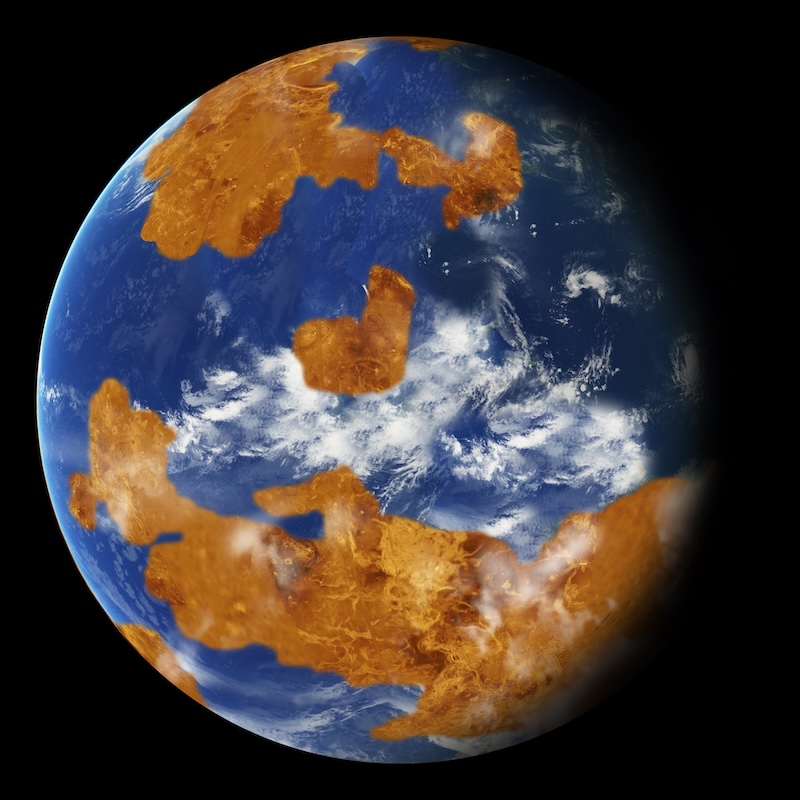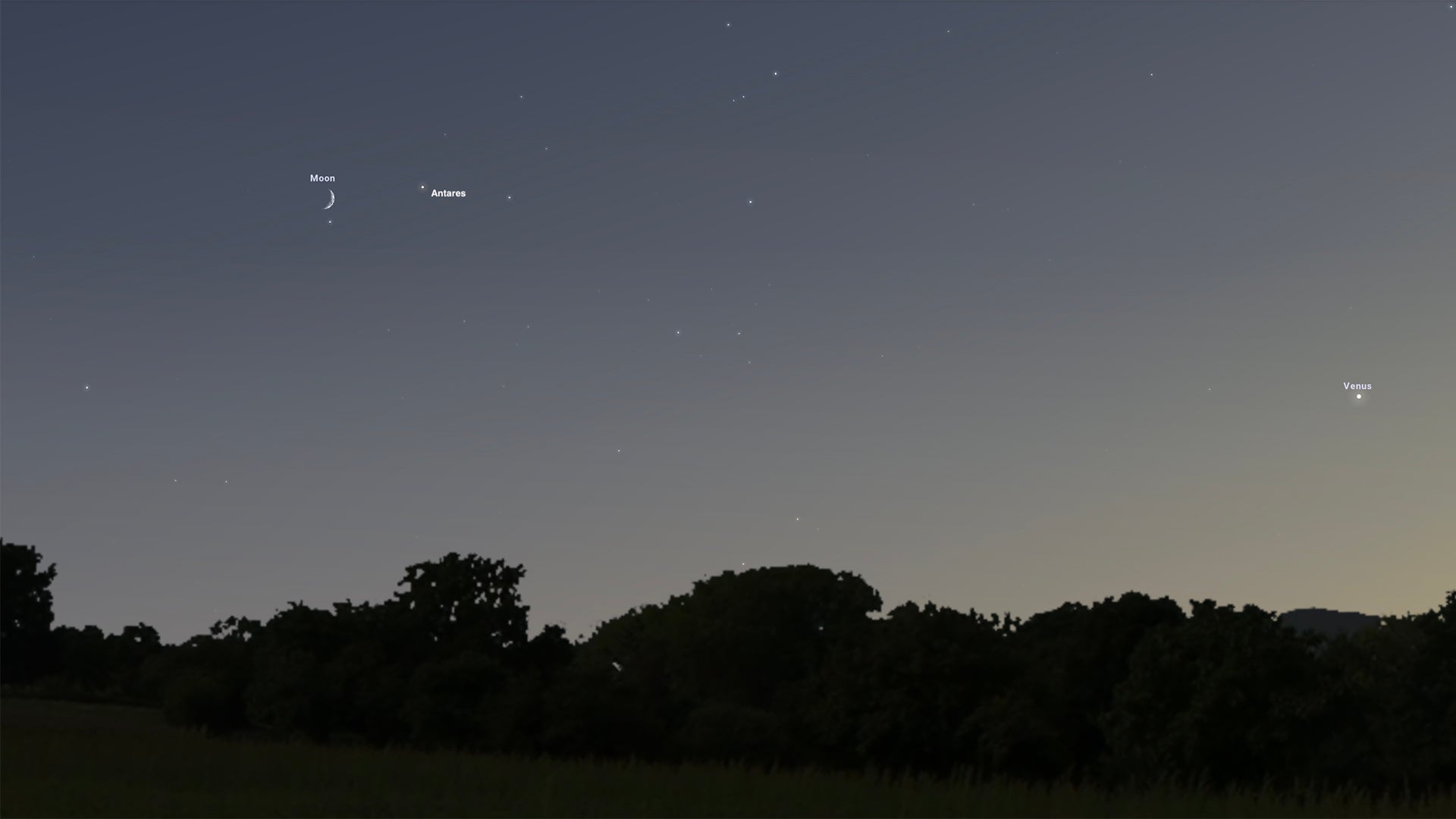*
- Venus, the world next-inward from Earth, is about the same size and density as Earth. But it’s hot enough on its surface to melt lead.
- Yet some studies have suggested oceans for Venus, billions of years ago, making it more Earth-like than it is today.
- Now a new study suggests Venus never had oceans. Researchers studied Venus’ atmospheric chemistry and concluded that there was never enough water in the planet’s interior to support oceans on its surface.
Did Venus ever have oceans? Was it ever habitable, even for some simple form of life, like microbes? Those are questions that scientists are still trying to answer. Some previous studies have suggested that the planet once was much more Earth-like, with lots of water on its surface. But now, a team of astronomers from the University of Cambridge in the U.K. are pointing to their new study, which disputes the idea of Venus oceans. They said on December 2, 2024, that their new work shows Venus likely never had enough water for oceans.
The journal Nature Astronomy published these researchers’ peer-reviewed study on December 2, 2024.
Looking for a great astronomy-themed holiday gift? The 2025 EarthSky lunar calendar is now available! A unique and beautiful poster-sized calendar. Keep up with all phases of the moon every night of the year.
Temperate world or born hot?
Scientists have two main theories for what Venus was like billions of years ago. One says that the planet was similar to Earth, with abundant water on its surface. That theory supposes the water subsequently disappeared as Venus’ atmosphere thickened, leading to the a runaway greenhouse effect – whereby a greenhouse gas like carbon dioxide blocks heat from leaving the planet’s surface – seen today on Venus. Carbon dioxide buildup in the Venus atmosphere caused temperatures to soar, producing the hellishly hot world we see today.
The other theory says that Venus – the 2nd world outward from the sun, closer to the sun than Earth – was born hot and has always been scorching. But which theory is more accurate?
Studying Venus’ atmospheric chemistry
To try to find the answer, the researchers looked at the current chemistry in Venus’ atmosphere. Tereza Constantinou – lead author of the new study – is a PhD student at Cambridge’s Institute of Astronomy. She said:
Both of those theories are based on climate models. But we wanted to take a different approach based on observations of Venus’ current atmospheric chemistry. To keep the Venusian atmosphere stable, then any chemicals being removed from the atmosphere should also be getting restored to it, since the planet’s interior and exterior are in constant chemical communication with one another.
These scientists’ statement explained:
Volcanism, through its supply of gases to the atmosphere, provides a window into the interior of rocky planets like Venus. As magma rises from the mantle to the surface, it releases gases from the deeper portions of the planet.
On Earth, volcanic eruptions are mostly steam, due to our planet’s water-rich interior. But, based on the composition of the volcanic gases necessary to sustain the Venusian atmosphere, the researchers found that volcanic gases on Venus are at most 6% water. These dry eruptions suggest that Venus’s interior, the source of the magma that releases volcanic gases, is also dehydrated.

Implications for life
If Venus was always dry, that fact would have implications for possible life. It would diminish the chances of life having started billions of years ago on the planet’s surface, as well as the possibility that microbial life might exist now, as some have suggested, in Venus’ clouds. The possibility of life in Venus’ clouds has been a topic of much debate and controversy in recent years. Constantinou said:
We won’t know for sure whether Venus can or did support life until we send probes at the end of this decade. But given it likely never had oceans, it is hard to imagine Venus ever having supported Earth-like life, which requires liquid water.
Scientists supporting the idea of microbial life in Venus’ clouds have suggested that it might have started when – or if – the planet first had water on its surface. Those organisms might later have retreated to the planet’s atmosphere, when conditions on the surface became inhospitable.
But even that scenario requires water on Venus’ surface at some point. The key question is … was life ever able to gain a foothold on Venus?
Venus as an exoplanet analog
Knowing how Venus became the scorching world it is today will be a boon to those searching for possible life on distant exoplanets. As Constantinou noted:
Even though it’s the closest planet to us, Venus is important for exoplanet science, because it gives us a unique opportunity to explore a planet that evolved very differently to ours, right at the edge of the habitable zone [the zone around a star in which liquid water might exist on a world’s surface].
If Venus was habitable in the past, it would mean other planets we have already found might also be habitable. Instruments like the James Webb Space Telescope (JWST) are best at studying the atmospheres of planets close to their host star, like Venus.
But if Venus was never habitable, then it makes Venus-like planets elsewhere less likely candidates for habitable conditions or life.
We would have loved to find that Venus was once a planet much more like our own, so it’s kind of sad in a way to find out that it wasn’t. But ultimately it’s more useful to focus the search on planets that are mostly likely to be able to support life, at least life as we know it.
Venus Probably Never Had Oceans – It May Always Have Been Hell
— IFLScience (@IFLScience) December 2, 2024
Future missions
Determining Venus’ history for certain will require future missions back to the planet, which are being planned now. For example, NASA’s upcoming DAVINCI (Deep Atmosphere Venus Investigation of Noble gases, Chemistry and Imaging) mission is scheduled to launch sometime in the late 2020s. It will conduct multiple flybys of Venus as well as send a probe down to the surface. DAVINCI will study the origin and evolution of Venus, examining both its geology and atmosphere.
Meanwhile, NASA’s VERITAS (Venus Emissivity, Radio science, InSAR, Topography And Spectroscopy) mission has faced some delays. As of now, it is due to launch no earlier than 2031. It will create new radar maps of Venus’ surface and produce the first maps of surface rock composition. VERITAS will also search for thermal signatures of active volcanism and chemical signatures of recent volcanism.
The European Space Agency’s Envision mission is also expected to blast off for Venus in 2031. It will also study the planet from its core to its atmosphere in great detail.
Rocket Lab’s Venus Life Finder will be the first private mission to Venus. It will focus on searching for organics in the habitable region of Venus’ atmosphere. This is an in-situ follow-up to the still-debated discovery of phosphine – a possible byproduct of microbial life – in that region.
Bottom line: Researchers at the University of Cambridge say it’s likely there were never any oceans on Venus. The planet might have always been as hot as it is now.
Source: A dry Venusian interior constrained by atmospheric chemistry
Via University of Cambridge
Read more: Giant craters on Venus ‘hiding in plain sight’
Read more: Active Venus volcanoes revealed again in Magellan data




